![]()
 |
The Pegmatyte Veins of Pala, San Diego County
By G. A. Waring, Stanford University, California
An article originally published in
The American Geologist,
Vol. XXXV, No. 6 (June 1905), pp. 356–369.
The writer is indebted to Dr. J. P. Smith, of Stanford University, for advice in the preparation of this article.
Concerning the region with which this paper deals, Fairbanks [1] has said: “The structure of San Diego county is comparatively simple. Three main divisions might be made: the desert region on the east, the Peninsular range of crystalline rocks in the middle, and the nearly level mesa on the west. The higher mountains are formed wholly of ancient crystalline schists and massive rocks.”
 |
| Fig. 1. Sketch map of western San Diego County. |
It is with this middle division, or rather the part of it lying between Temecula canyon and the Palomar’s mountains, that we have to deal. The Palomar’s mountains are composed of mica schists but the lower lying hills and mountains of the region are of granite and diopter, and according to the writer’s observation the structure is that of intrusive diopter dykes and later granite intrusions within the main granite mass. These dykes in the western part of the area in question have a rather constant N. E.–S. W. strike. They are of considerable extent, the one embracing Red mountain, near Fallbrook, being fully a mile wide, while the smallest one traced was about two hundred yards wide.
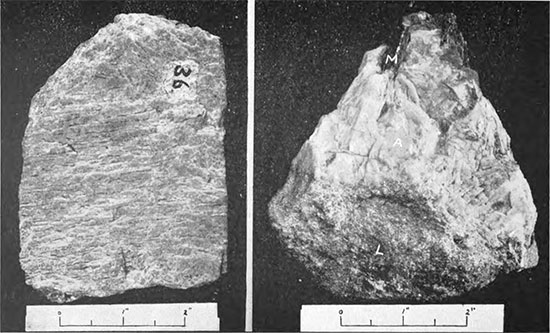 |
| Plate XXII. Fig. 1 (left) Graphic Granite. Upper part of pegmatyte veins. Fig. 2 (right) “Pay streak” matter. Central part of pegmatyte veins. M = Muscovite; A = Albie; L = Doolittle. |
Toward Pala the general strike of the dykes swings to the N. W.–S. E. The contact lines are usually well marked by a change in the character of soil and vegetation, and by intrusive lenses of the diopter in the granite at the contact. The normal diopter is composed of green hornblende and plagioclase, in a few places also carrying hypersthene. At Pala the rock is more basic, becoming a hypersthene gabbro or noryte. Smaller dykes occur in the granite, but these are of a granulitic structure. Three types have been observed: green hornblende granulyte, garnet granulyte, and biotite granulyte.
The granite also varies in texture. Two kinds occur, one locally called “blue granite,” in which the hornblende is altering to chlorite and the oligoclase shows marked zonal structure; and a lighter variety, containing little hornblende. West of Fallbrook the darker variety appears as intrusive more resisting areas in the lighter. To the east the Vallecitos valley is a region of light colored granite, varying from a rock almost without hornblende to areas containing large patches of this mineral. The origin of the valley is thought to be due to the differential weathering of this granite. Veins of feldspar cut the granite in all directions.
The varying texture of the country rock is well shown by the section as described by Fairbanks, [2] exposed in Temecula canyon. “A wholly different series of rocks is exposed in Temecula canyon not more than two miles north of the country just described, [Vallecitos]. This canyon is deep and rocky, taking a very direct course from Temecula to the ocean. At the upper entrance there is a narrow exposure of granite. This is followed by quartzyte dipping 45° southwest. The rocks shortly become massive and are replaced by dark syenitic ones with an excess of hornblende. Two miles down, granite appears for a short distance, and in it a quarry has been opened. Gneissoid rocks soon replace the granite and these are followed by hornblendic rocks which vary from a schistose to a massive structure. In places they contain feldspars and pass into syenytes; in others the rock is almost pure hornblende. The syenytes are followed by mica schists and these by coarse biotite granite about five miles above Howe [Fallbrook] station. In the granite are many pegmatitic veins, carrying biotite, garnets, and tourmaline. Fine-grained granite, varying at times to syenyte, forms the rock along the canyon for many miles below this point.”
Topography. The Fallbrook region is a rolling plateau of from six hundred to eight hundred feet elevation. From Oceanside to within five miles of Pala, the San Luis Rey river lies in a broad sandy valley. The mountains then close in for about two miles, making a narrow canyon, but at Pala the river valley opens out into a flat alluvial plain from one to two miles wide, extending south-eastward to the foothills at Rincon. Loose boulders and gravel strew the floor of this plain and of the small side valleys. The river keeps close to the south side of the valley and a few miles above Pala has cut a channel in this wash formation nearly one hundred feet below the floor of the plain.
Veins and Dykes. The large intrusive dioryte areas are cut by veins composed chiefly of feldspar, biotite and black tourmaline. Many small veins also cut the granite area, but these contain only feldspar and biotite, without tourmaline.
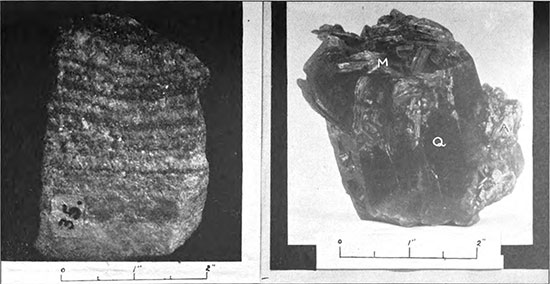 |
| Plate XXIII. Fig. 1 (left) Garnet Quartzyte. Lower part of pegmatyte veins. Dark bands are composed of minute garnets. Fig. 2 (right) Quartz crystal intergrown with muscovite (M) and albite (A). |
Two regions of apparently intrusive granite have been observed[:] the beryl region of Rincon, which will be described later, and a small area four miles southeast of Fallbrook. At the latter place two prospect shafts have been sunk[:] one of six feet, the other of twenty-six feet in depth, on a pegmatyte vein in search for gems. This vein is about twenty inches wide, striking N.–S. and dipping 80° to the east. The vein is well defined from the decomposed country rock. It does not outcrop, but is marked by a local[,] more resisting character of the granite on the east wall, making a distinct ridge about ten inches high and two feet wide. A slight pegmatitic structure is shown in the west side of the vein. The whole width consists of quartz, feldspar, and muscovite. A little fibrolite is developed near the center of the vein,—a mineral not known to occur in any other vein of the region. A few pockets have been found here, and some fine specimens of quartz enclosing black tourmalines taken out, but no gems.
About two miles southwest of Fallbrook station, in Temecula canyon there is a dyke of hypersthene dioryte and in it a pegmatitic vein several feet wide. This shows a graphic structure on the hanging-wall side and a banded garnet quartzyte on the footwall side. Muscovite and black tourmaline are developed to considerable extent but otherwise the vein is not mineralized.
 |
| Fig. 2. Contour map of Pala Region. |
Structure of the Pegmatyte Veins. This pegmatic structure is best developed in an area about one and a half miles wide and four miles long, lying northeast of Pala, as shown in fig. 2. This consists of a noryte boss within the granite. The contact with the granite is well marked on the east, north, and west; on the south it is covered by the loose gravels of the valley. A number of pegmatyte veins cut through the noryte, dipping rather uniformly S. 45°–50° W. at an average angle of about 30° with the horizontal. These veins have a very uniform structure, like that shown in fig. 3.
 |
| Fig. 3. Dyke Structure. 1 = coarse pegmatite; 2 = graphic granite; 3 = “paystreak”; 4 = garnet quartzite; 5 = norite. |
There is a distinct contact between the noryte (5) and upper portion of the vein. This upper portion (1) consists of a coarsely crystalline pegmatyte rich in mica and black tourmaline. This grades into a fine grained graphic granite (2) in which is often a little mica. Plate xxii. fig. 1, is of a hand specimen of this rock. The graphic granite grades downward into the “pay-streak” (3) in which the rarer minerals are found. Fig. 2, plate xxii, shows a piece of this part of the vein, containing lepidolite, albite and muscovite. Pockets occur in this layer, lined with crystallized quartz and feldspars and containing crystals of tourmaline, kunzite and orthoclase, usually embedded in a clayey matrix. Between the paystreak and lower portion (4) of the vein the contact is sharp. This lower part consists of a banded garnet quartzyte, making a distinct c0ntact with the noryte. A peculiarity of this is that it always composes one-half the thickness of the vein and that the minute garnets have a banded arrangement, often much crumpled. Plate xxiii, fig. 1, is of a hand specimen of this rock.
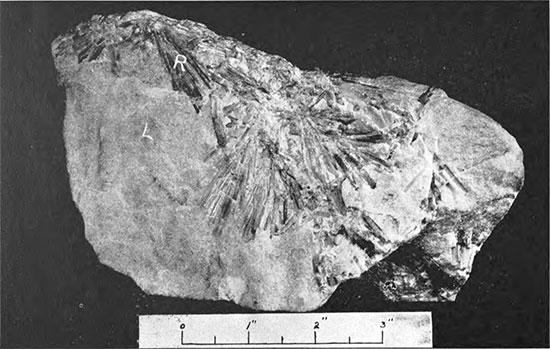 |
| Plate XXIV. Lepidolite (L) containing radiating crystals of rubellite (R). |
Veins of the Pala Region. By far the largest and most distinctive vein is near the western side of the noryte boss. The outcrop is on the east slope of the hill and is plainly traceable for over half a mile. The northern portion consists mainly of pegmatyte, with no tourmaline or lepidolite. About the middle of its exposed length, black tourmalines appear in a coarse quartz-feldspar-mica matrix. Often these tourmaline crystals, several inches in length, are broken into many pieces and displaced slightly. Lepidolite begins to show here in small veins, and farther south at the lithia mine, it develops into a large mass-60 feet through in the thickest place. This mass consists of small particles of lithia mica and feldspar. Near the southern end of this are found the beautiful specimens containing radiating bunches of rubellite, a specimen of which is shown in plate xxiv. Still farther toward the southern end of the outcrop only black tourmaline occurs.
Two smaller veins outcrop on this hill, farther west, and exposed higher up. On them are located the Tourmaline King and Tourmaline Queen mines, from which some gem tourmalines have been taken. The next vein of note east of the big lithia deposit is that of the Pala Chief kunzite mine. The vein has the same structure as the others; pockets seem more plentiful, however, and in them are found quartz crystals of large size. The eastern part of this noryte area contains many veins, often only a few feet apart. Some difference in the occurrence of the rarer minerals is noted in the veins though no strict rule is followed. In a general way, however, in the westernmost veins lepidolite is more plentiful, tourmaline in the more central, and kunzite in those to the east.
Character of the Intrusive Rocks. The gabbro of this area varies in texture from a fine-grained hypersthene rock to one containing large feldspars with only green hornblende. Near the eastern end of the noryte is a small area, only a hundred yards in extent, over which the surface is strewn with rounded pebbles from one to three inches in diameter. These “orbicules” have resulted from the weathering of an orbicular gabbro, resembling that of Dehesa, California, described by Lawson [3] and by Kessler and Hamilton [4]. A few hundred yards to the west the orbicular rock gives place to a very coarse-grained gabbro, which grades into the noryte.
Minerals Occurring in the Pockets. The minerals occurring in the pockets of the veins are: quartz, crystallized out on the sides, both of the clear and smoky varieties. These crystals are notable for the rather common development of rare crystal faces. Hyalite and rose quartz are also sometimes found. Albite occurs with quartz, lining the pockets, and has a tabular habit of crystallization. Orthoclase is usually found in pockets as individual crystals in the clay and is of the aventurine variety. It consists of microcline and albite in alternate bands. Muscovite, usually of a greenish tint, is found in plates of considerable size within the pockets, as scales or flakes making up a considerable part of the clay, and as minute scales included in other minerals. Lepidolite when found in pockets is usually near the central part, and embedded in it are often found gem tourmalines and kunzite. This latter is often in fresh fragments and splinters, and also in fragments showing corrosion or decomposition.
Crystals tend to grow to large size in these pockets. Although any one mineral may occur to the exclusion of the others, when several are found together, the orthoclase and kunzite are near the center, while the albite and lepidolite are near the walls. It is rare that kunzite and tourmaline occur in the same pocket. Even when in the same ledge, they are some distance apart.
Vein Minerals. Quartz, albite, muscovite and black tourmaline make up a good part of the paystreak. The mica often shows a crossing of plates as if of twinning but this is not shown by the optical figure. It is probably due to crushing or sliding action. The black tourmalines are also often intergrown and distorted, besides being broken. Lepidolite, varying in quality from the nearly pure lilac-colored lithia mica to that containing much feldspar, and amblygonite occur in masses of several tons weight. The amblygonite is found as a rule below the lithia deposits. Triplite is found in masses of several pounds weight, almandine and vermiculite occur to some extent, and about five pounds of sulphide of bismuth have been found in one place in amblygonite. This is the only metallic mineral so far known in this locality.
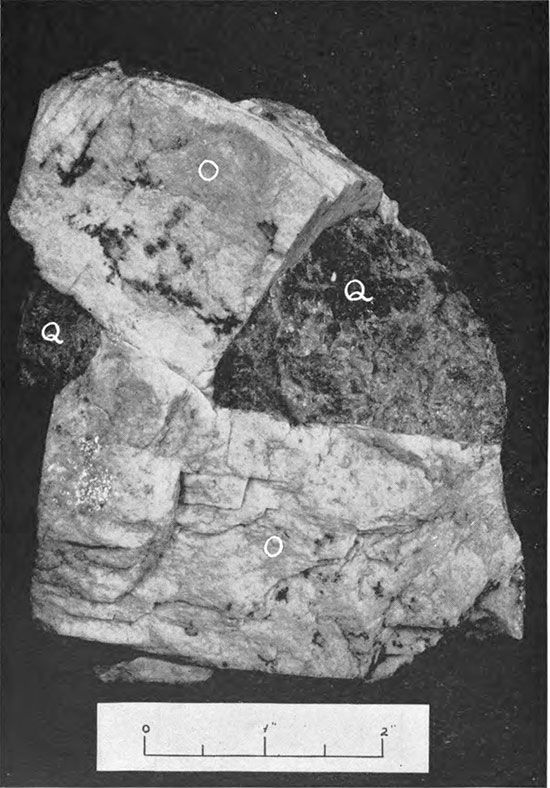 |
| Plate XXV. Coarse pegmatyte from Rincon, Q = Quartz, O = Orthoclase. |
Clays in the Veins. At least three kinds of clay from the kunzite bearing pockets are recognized, known locally as kunzite clay, kunzite and tourmaline clay, and lithia clay. A physical analysis of these has been made, by specific gravity methods.
Below is the average mineral composition of them:
 |
These analyses show that the amount of feldspar and quartz is about the same in all—83% to 86%—while the percentages of muscovite and rarer minerals vary considerably.
The halloysite is a pink clay apparently derived from rubellite, for all gradations from unaltered tourmaline to the chalky clay can be found. An analysis of it as given by W. T. Schaller [5] is as follows:
| SiO2 | LiO2 | .23 | |
| Al2C3 | 35.55 | Na2O | .19 |
| Fe2O3 | .21 | K2O | .03 |
| MnO | .26 | H2O (107°) | 6.63 |
| CaO | 1.02 | H2O (above 107°) | 12.25 |
| MgO | .19 | TiO2 | n o n e |
| 100.18 |
This analysis agrees closely with the formula H4Al2Si2O9+H2O. It will be noticed that no boron was found in this clay.
A small amount of a white finely granulated mineral has also been found in the pockets. The microscope shows it to be composed almost wholly of fresh angular fragments of feldspar, which contains manganese.
The Rincon District. Eastward toward Rincon the vein structure again becomes evident on the north side of the valley, and at the base of the Palomares mountains above Rincon another mineralized area occurs. But here the country rock is mainly a decomposed granite, with the veins standing out prominently. These have the usual structure but the association of minerals is somewhat different. Crystals of quartz, orthoclase and beryl are the pocket contents. Black tourmaline, patches of massive almandine and large beryls are common in the hard pegmatitic material. Greenish muscovite is also very noticeable in patches several inches in extent. The pegmatyte in some places has a very coarse structure in which the individual quartz and orthoclase crystals are several inches in extent, as shown in plate xxv.
Only two veins have been prospected enough to show the occurrence of minerals. From the lower of these, over $2,000 worth of gem beryls have been taken with the removal of hardly a hundred cubic yards of material. The beryls occur in clay[,] in pockets[,] usually not over eight inches in diameter, in the central portion of the ledge. In the upper vein are found many pockets filled with a red clay composed of mica and iron-stained kaolin. Many small beryls occur in this, but are uniformly of a milky hue. Smoky quartz, often intergrown with mica (plate xxiii, fig. 2), and orthoclase crystals (plate xxvi, fig 1), several inches in diameter are found in the larger pockets. The latter are of the aventurine variety, and the surface is often corroded into a series of sharp ridges by the removal of microcline and greater resistance of the albite to alkaline waters, as shown in the twin crystal illustrated. Iron oxide also seems to be deposited by these waters, in the interstices of the crystals, staining them red. Many of the beryls are also corroded or partly dissolved, as shown in plate xxvi, fig. 2.
Neither kunzite, lepidolite nor amblygonite has yet been found in this region. Albite also is rather uncommon.
Spring Waters. The waters of three springs—one from Rincon and two from near Pala—have been tested spectroscopically for lithia but show no trace. They are all three alike in containing only about eighteen grains of solid matter to the U. S. gallon. This consists mostly of the chlorides and carbonates of potassium, sodium and calcium.
Origin of the Veins. All the observed facts point to the hydrothermal origin of these veins. As Lehmann [6] expresses it[:] “as a result of crystallization of a parent mass and the concentration of water in the residual uncrystallized part, a gelatinous magma rich in silica is formed. Between such a gelatinous magma and a saturated aqueous solution a large number of consecutive intermediate stages can be imagined.” Such a cooling and crystallizing magma would fulfill all the conditions demanded by the structure of the veins of this region. The three phases of pegmatization as given by Van Hise [7] seem exhibited in these dykes.
The graphic granite without doubt represents crystallization from a solution mainly aqueous, the central mineralized portion hydro-thermal action, while the lower garnet quartzyte crystallized from a more gelatinous magma.
Thin sections of the graphic granite[,] cut perpendicular to the long axes of the crystals[,] show the quartz all to be oriented the same way. Sections of the garnet rock show the minute garnets to be perfectly formed. The following points advanced by W. O. Crosby and M. L. Fuller [8] in support of the aqueo-igneous theory are all borne out by the character of the veins in question. They are: the occurrence of rare minerals; the formation of large crystals; the banding and comb structure of tourmalines, etc. normal to the walls; water inclusions in the quartz; and the occurrence of pockets and druses. There is always one normal plutonic rock in every pegmatyte region, of similar but less acid character, from which the pegmatyte is evidently derived. The normal country granite apparently occupies this position here.
In summary Van Hise says: “Pegmatization when it occurs on a great scale usually is found in connection with great intrusive masses in which there have been long-continued composite intrusions. No great batholith is the result of a single simple intrusion. The introduction of such masses went on irregularly through a very long time. Pegmatyte masses are not the result of a distinct epoch of eruption, but usually are produced in connection with the dosing phases of igneous activity. * * * As the pegmatytes close to the central mass solidify, a large portion of the water is expelled and travels outward to help form the pegmatyte rock having a more distinctive vein character.”
As before stated, the banded quartzyte very constantly forms the lower half of the Pala and Rincon pegmatitic veins. In explanation to this it is now suggested that this material first occupied the fractures in the cooling noryte boss as a hydrous magma, and that on crystallizing it contracted to approximately half its former volume. Toward the later stage of crystallization garnets developed, aided by contact action of the noryte, but were unable to reach any considerable size. Later a more aqueous magma was forced up through the reopened crevices and formed the upper portion of the veins. The pockets seem to be of later origin. The crystallization in them of the residual rare elements as complex silicates and the occurrence of large quartz and orthoclase crystals supports this theory.
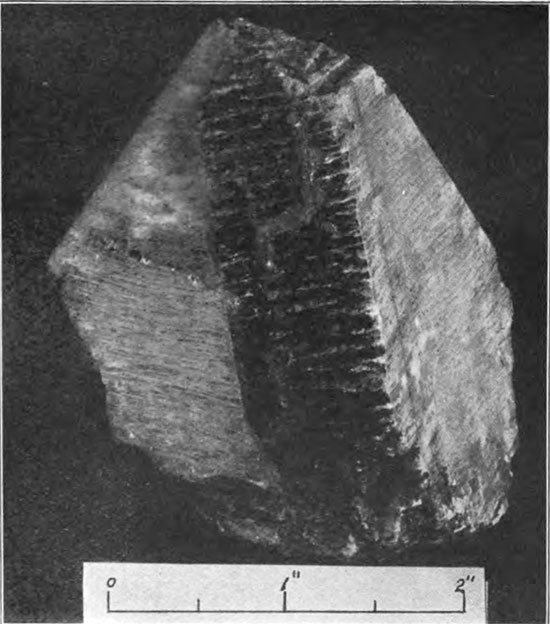 |
| Plate XXVI. Fig. 1 (above). Orthoclase crystal from Rincon, showing corrosion due to meteoric waters. Fig. 2 (below). Corroded beryls from Rincon, showing action of meteoric waters. |
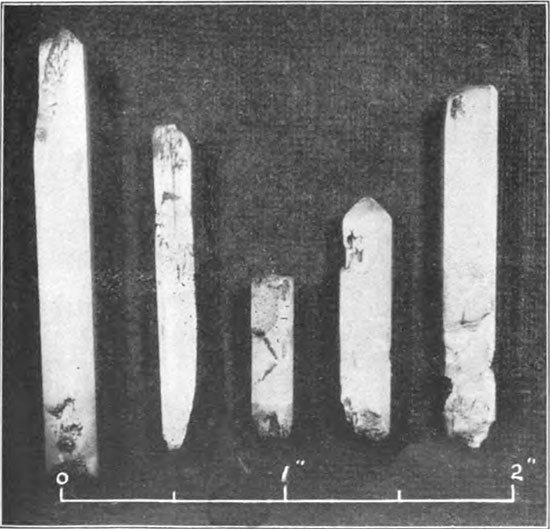 |
None of the minerals of the rare elements, tourmaline, spodumene, beryl or lepidolite, occur outside of the pegmatitic formation.
None of the common rock-forming minerals could take up these rare elements, and an igneous magma is not conducive to their crystallization as complex silicates; hence they remained uncombined until forced out with the eruption of the pegmatyte. In this hydrous magma[,] conditions were favorable, so they crystallized out as the rarer silicates. The plentiful occurrence of tourmaline indicates fumarole action also to have been a prominent factor in this period.
Types of Veins. The different types of veins observed may now be summed up into six classes.
- Veins in the normal granite, containing only orthoclase and biotite.
- Veins in the normal dioryte, containing quartz, feldspar, biotite and black tourmaline.
- The pegmatitic vein in intrusive (?) granite, (east of Fallbrook), containing quartz, feldspar, mica, black tourmaline, fibrolite, and quartz crystals enclosing black tourmalines.
- The pegmatitic vein in hypersthene dioryte (in Temecula canyon) showing graphic granite and banded quartzyte structure, but not mineralized.
- Pegmatyte veins of Pala in noryte, highly mineralized, containing lepidolite, amblygonite, spodumene, tourmaline, quartz and feldspars.
- Pegmatyte veins of Rincon in intrusive (?) granite, also mineralized but with a different association of minerals—quartz, orthoclase, muscovite and beryl.
From the previous discussion it is seen that the most highly mineralized veins are in an area of noryte—a basic hypersthene rock. The more acid hypersthene-bearing dykes show the pegmatitic structure, but are not mineralized, while in normal dioryte and granite, no pegmatitic structure was observed.
The present surface near Pala probably represents the original zone of anamorphism at the time of intrusion, while the more acid diorytes of Fallbrook may represent an original zone nearer the former surface. In support of this theory are advanced: (1) the evidences of great erosion shown in and about the Pala valley, (2) the more basic nature of the rocks, according with deeper seated conditions, (3) the occurrence of the heavy minerals—garnet and triplite—and especially of the suphide of bismuth, (4) the shape of the noryte area, more resembling a neck or boss than a dyke. The occurrence of epidote and fibrolite—secondary minerals typical of the zone of katamorphism—in the Fallbrook, but not in the Pala region, is another point in support of this theory. Of the two hornblende granulytes studied, occurring as small dykes in the country rock, that from Pala shows more tendency toward recrystallization of the minerals, than does the Fallbrook rock, also indicating a greater depth of formation for the former. The general occurrence of potash feldspar in the triclinic form, microcline, may be taken partly as an evidence of pressure due to depth, though it is the usual variety occurring in pegmatytes. Several minerals show the effects of crushing and slight displacement, as black tourmalines and crossed plates of mica. The fresh granulated feldspar also shows the results of crushing. Evidently considerable orographic movement has caused this.
Alteration of the Minerals. Since the time when erosion brought the present accessible part of the veins above the zone of anamorphism considerable alteration of the minerals has taken place. The spodumene is often fractured and pitted and contains patches of kaolin-like material. The alteration to beta-spodumene and finally to muscovite and albite as in the Branchville, Conn. variety is not shown in thin sections of the Pala mineral. The decomposition of rubellite to halloysite has been mentioned. Vermiculite occurs to some extent as an alteration of the mica, especially at Rincon. The alteration of microcline and albite to kaolinite and muscovite with the liberation of silica and the alkaline carbonates seem to take place to considerable extent, and is thought to be the origin of the clay of the pockets. These reactions take place with a decrease in volume of from 5% to 16%, assuming the silica to crystallize as quartz and the carbonates to be carried off in solution,—facts according with the conditions revealed in newly opened pockets. Perhaps the best example of alteration is presented in the pockets at Rincon. Here corroded crystals of orthoclase (plate xxvi. fig. 1) and corroded beryls (plate xxvi. fig. 2) occur together in a matrix of sticky red clay composed for the most part of iron-stained mica and kaolin. It seems clear that the microcline has first yielded to the meteoric waters and been reduced to kaolin and mica. The waters, made more alkaline by the liberated potash[,] have then attacked the beryls and partly dissolved them. Muscovite often occurs as fine flakes on the larger beryls, seemingly as a product of alteration. The very interesting series of reactions that have taken place here well deserve further study. The relation of the amblygonite to lepidolite, the decomposition of spodumene and the reactions between the feldspars and beryl especially present reactions worthy of examination. Some attempt has been made to trace the rare elements when alteration takes place, but no secondary minerals of boron or beryllium, derived from tourmaline or beryl, are known to occur; neither do ordinary tests show the presence of these elements in the surface waters. It seems probable however that they are carried off as soluble salts, but in quantities so small as easily to escape notice. The failure to find lithia in these waters might be expected, for the lepidolite is always fresh and unaltered.
- H. W. Fairbanks—Geology of San Diego County; also portions or Orange and Bernardino Counties. Eleventh Annual Report of California State Mineralogist, p. 76. [return to text]
- Eleventh Annual Report of California State Mineralogist, p. 101. [return to text]
- Bull. Dept. Geol. U. Cal., vol. iii No. 17, Mar. 1904. The Orbicular Gabbro at Dehesa, San Diego Co., Cal ., by A. C. Lawson. [return to text]
- The Orbicular Gabbro of Dehesa, Cal ., by H. H. Kessler and W. R. Hamilton, The American Geologist. Sept., 1904. [return to text]
- American Journal of Science, Mar. 1904. Notes on some California Minerals. By Waldermar T. Schaller. [return to text]
- Monograph xlvii U. S. Geol. Survey. Van Hise. A treatise on Metamorphism, p. 722. [return to text]
- Monograph xlvii U. S. Geol. Survey. Van Hise. A treatise on Metamorphism, p. 725. [return to text]
- Crosby, W. O. and Fuller, M. L., Origin of Pegmatite. Tech. Quar., Vol. 9, 1896, pp. 326–356. [return to text]